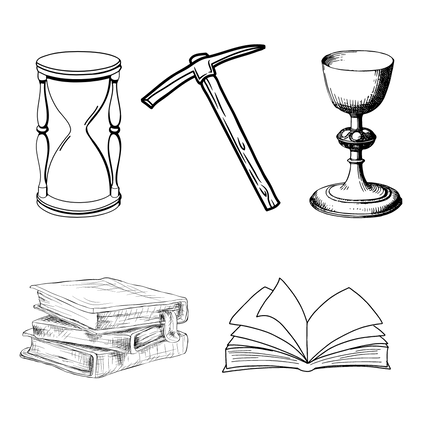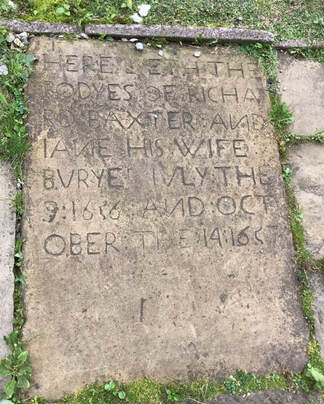What Can We Learn From a Grave?Gravestones can provide a wealth of information to those who know how to interpret them. Here are some of the key pieces of information that can typically be learnt from gravestones:
Name and Dates – Obvious? Not always Gravestones usually bear the name of the deceased, along with their birth and death dates. This basic information can be crucial for genealogical research and tracing family histories. Older stones can be small and simple markers with just the occupiers’ initials. Weather damage over as little as a decade can leave a stone completely unreadable. Family Relationships Some gravestones may also indicate familial relationships, such as "beloved husband/wife of..." or "father/mother of...". These can provide insights into family structures. Epitaphs Many gravestones feature epitaphs, short phrases or sentences that summarize the person's life, personality, or beliefs. Epitaphs can offer glimpses into the values and sentiments of the deceased and their loved ones. An example on the above image is ‘In the Midst of Life we are in Death’. Below is another one from a stone at St. Oswald's in Winwick. Religious Affiliation
Symbols, inscriptions, or imagery on gravestones can indicate the religious beliefs of the deceased or their family. For example, Christian gravestones might feature crosses, while Jewish gravestones may have Hebrew inscriptions. Military Service Gravestones of military personnel often include information about their service, such as rank, branch of service, and any notable achievements or honours received during their service. Cultural and Ethnic Identity Gravestones may incorporate symbols or motifs that reflect the cultural or ethnic identity of the deceased or their community. Social Status The size, style, and material of a gravestone can sometimes provide clues about the social status or wealth of the deceased. Elaborate monuments and mausoleums are typically associated with wealthier individuals or families. Historical Context Gravestones can offer insights into historical events, trends, and cultural norms of the time period in which they were erected. Changes in gravestone styles and inscriptions over time can reflect shifts in society's attitudes towards death and commemoration. Overall, gravestones serve as markers of individual lives as well as offering glimpses into the past and providing valuable information for those interested in understanding the lives and legacies of those who have passed away. Gravestone SymbolsGravestone symbols are rich in meaning, often representing religious beliefs, cultural traditions, or personal attributes of the deceased. Here are explanations of some common gravestone symbols:
Cross Although the cross is one of the most widely recognized symbols in Christianity, it was rarely used before the Victorian period except on Roman Catholic graves. It signifies faith in Christ and hope for eternal life. Star of David A six-pointed star, the Star of David is a symbol of Judaism and is often seen on Jewish gravestones. It represents the Jewish faith and identity. Angel Angels are often depicted on gravestones as guardians or messengers of God, symbolizing protection, guidance, and the belief in an afterlife. They can range from a chubby-cheeked cherub to a full standing figure. Dove The dove is a symbol of peace, purity, and innocence. With a twig in it’s mouth it could mean hope or promise. Skull and Crossbones This symbol, often wrongly associated with piracy, can also be found on many older gravestones. The skull and two thigh bones are believed to be the parts of the body required for resurrection. Serpent The encircled serpent biting its tail is a symbol of eternity. Lamb
A lamb is a common symbol on gravestones, particularly those marking the graves of children. It symbolizes innocence and purity. The Latin AGNUS DEI is sometimes shown, meaning ‘Lamb of God’. Broken Column A broken column on a gravestone often represents a life cut short, typically that of a young person or someone who died prematurely. It symbolizes the unfinished nature of their life and the sorrow of those left behind. Anchor The anchor is a symbol of hope, steadfastness, and eternal life in Christianity. On gravestones, it can represent the deceased's hope for salvation and their belief in Christ as their anchor. Tree Trees symbolize life, growth, and the cycle of renewal. On gravestones, they can represent the idea of the deceased's spirit living on or the family tree, signifying connections between generations. Wheat Along with other symbols such as oak leaves, wheat shows a long life, one that was harvested by the reaper when it was time. Clasped Hands Represents friendship or love, or a sign of being reunited with a loved one in heaven. Tools Tools of a person’s trade are common on memorials. A pickaxe is one example for a tradesman, or a chalice may mean the grave of a priest. Hourglass An hourglass is a symbol of the passage of time and mortality. It reminds viewers of the transient nature of life and the inevitability of death. Books A book or books, open or closed can refer to the Bible or to knowledge of the deceased. Common Phrases and Letters on GravesXP
The first two letters of the Greek word for Christ IHS IESUS HOMINEM SALVATOR/Jesus, Saviour of Mankind INRI IESUS NAZARENUS REX IUDAEORUM/Jesus of Nazareth, King of the Jews 2B/2 Breadths A single grave or plot for two people Gravestones and LedgersLedgers are those stones lying flat, whilst vertical slabs are referred to as gravestones.
The earliest ones to be found today are usually from the 17th Century onwards. Some are just small marker stones with initials and a year, others are larger but they are often poorly laid out with words spread over two lines and sometimes have extra letters squeezed on afterwards. Through the 18th Century, stones did tend to increase in size, though they were still for the more affluent members of the community. Most were still just a simple rectangle slab.
In the early 19th Century, things started to become more elaborate, with bigger stones and different shapes and fonts. Monuments were built in the style of crosses, columns and Angels. Throughout the Victorian era, the most popular shape seems to be the Lancet. Chest and Table TombsThough the bodies were buried underground in the usual way, those who could afford it had a large chest or slab propped up above the body.
Cast Iron railings sometimes surrounded these as protection from body-snatchers. In most cases, the Iron was removed during the Second World War for scrap metal. |
AuthorCheyvonne Bower Archives
July 2024
Categories
All
|








